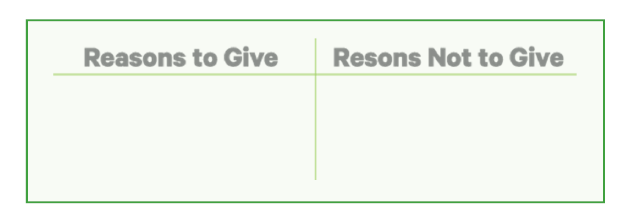Determining your healthcare development strategy can be complex and challenging, and it’s therefore vital to establish a process in order to improve the quality and efficiency of your interactions with a prospect. Every week, we’ll cover a new phase in our program to becoming a top producer in healthcare philanthropy.
Our key steps refer to the process development officers go through when interacting with each prospect. These steps are intended to be used as a guide to improve the quality and efficiency of every interaction with a prospect or donor. While some may move more quickly or slowly than others, all prospects go through each of the steps in the process. By being prepared and utilizing these steps, development officers can effectively reduce any tension between the officer and the prospect, sharpen communication skills, and generate a sense of professionalism and confidence. In the following blog series, Tips to Becoming a Top Producer in Healthcare Philanthropy, we will touch briefly on each of the key stages in the Gobel Group program, including pre-visit checklists and suggestions for talking points during each interaction, in order to assist development officers in aligning their prospects to the next stage, every time.
#8: Closing the Gift
In asking someone for a gift, there’s a significant difference between “soliciting” and “closing.” As a gift officer, you are giving your donor the opportunity to join in the common mission of making the organization, and thus the community, better. When you close, you’re essentially finalizing the prospective donor’s concluding decision as to whether they’re going to support the area of need. If you don’t ever “close,” you end up with numerous solicitations, but relatively little revenue coming into the organization. There are times in which that decision is “no.” However, “no” is a better answer than having no answer at all. Even if you hear a “no” at this stage, it still allows you the opportunity to move forward with the next action with another prospective donor.
Your two main goals for this visit should be to 1) work out the details of the gift (i.e. how much, for what purpose, terms of payment, etc.) and 2) work out the details for stewardship (i.e. general information, acknowledgement, recognition, etc.).
There are some good closing clues prospective donors demonstrate, both verbally and nonverbally, that can help you determine whether they have made a decision. Verbal cues include asking detailed questions about results, asking about recognition, or asking about the requirements that go along with making a gift. Nonverbal cues can include facial expression changes, a prospect possibly nodding in agreement, leaning toward you, or examining the product literature very intently. Recognition of these verbal and nonverbal cues is important, because they allow a gift officer to know when the proper time is to use a closing technique or strategy.
There are some great techniques that gift officers can use to get prospective donors to make a final decision. The use of each depends on the timing and the needs of the individual prospective donor.
Trial Close
This technique is similar to the soft ask. It sets up the donor to make that final “leap” into a decision. Some common language might include the following:
- “Can we show what your recognition looks like?”
- “Would you like to start on the first of the month?”
- “Would $5,000 per year be possible?”
The goal is to encourage the prospective donor to see themselves as already having made the decision by immediately confirming final details.
Summary Close
This technique reemphasizes the value-added donor benefits in a way that allows the prospective donor to see the “value” rather than the “cost.” For example, you might say, “That’s $5,000 per year, for five years, for a total gift of $25,000 to help 5000 patients annually with new testing, thanks to the cardio machine. Can I create a formal gift agreement with you?” In this scenario, it is the value of helping 500 patients that should be the most important part of the statement.
Assumptive Close
This technique is a subtle way to ask for a decision, assuming the prospective donor will decide positively. You could say something like, “Because this generous donation can meet your expectations, let’s go ahead and move this forward.” It should ordinarily be delivered near the end of the conversation or presentation. The goal with this sort of close is to get past any anxieties (if explained appropriately) to reaffirm the prospective donor’s desires.
Special Concession Close
This closing should be used only when the circumstances are appropriate. The goal of this technique is to allow the donor to “see a door closing on an opportunity.” Some sample “inducements” might include introducing the prospect as an initial/founding member of a Heritage Club, closing the fundraising effort, allowing the donor to be listed on an annual gift list, or informing the donor that their gift might move others to action. For example, you might say, “With this gift commitment, by the end of the calendar year, we will be able to recognize you as charter member of our Legacy Society.”
This technique is great for lead donors in a campaign. You might mention to your donor that their gift will encourage others to make similar gifts, because of the respect they have garnered in their community prior to making the gift.
It is important to note that this should be used with care. As a gift officer, you want to make sure of the details regarding the concession before offering it to a prospective donor.
Balance Sheet Close
This is used to show a prospective donor that the positives of a gift outweigh any concerns. It can be a good idea to use a simplified “pros and cons” list in order to reveal the benefits of your prospect’s gift (see diagram below).

While you may not actually write down the graphic above, when we think of the conversation in this way, it is easier to articulate to the prospective donor. You might say something like, “Based on our conversations, while the gift may be the largest you have ever made, the pledge plan works for you, it fits your desire to help cancer patients, and will be recognized by placing your name on the clinic. That sounds like the positives outweigh any concerns. Are you ready to move forward?”
It is important to note that you, as the gift officer, really have to know the prospective donor and their concerns quite well before using such a technique. You certainly don’t want the prospect to begin considering concerns now, thus changing the decision to give.
Management Close
With some large prospective donors or potential lead donors in a campaign, the prospective donor may need, or even expect, someone of authority – such as the hospital CEO, their individual physician, the chair of the board, or the Foundation’s president – to engage them before they make their final decision. With any of those individuals, their role is to bring the prospective donor to the final decision by indicating the prospective donor’s importance.
Remember: Regardless of how many times a gift officer and an authority figure have carried out such meetings, it is critical that before the meeting comes to a close, there is a conversation regarding roles, language, and outcomes. It is highly recommended that you and the authority figure engage in a practice session, to ensure all parties are aware of what to say, when to say it, and who is ultimately going to ask the prospective donor for a final decision.
At the point when the gift agreement is signed, CONGRATULATIONS, you’ve just closed a great gift. This is the time for you and your donor to celebrate. Before the visit concludes, be sure to discuss the acknowledgement and recognition of the gift.
Want to know more about becoming a top producer in healthcare philanthropy? Click here to read about the next stage, Stewardship, or click here to read the previous stage, Making the Ask.
